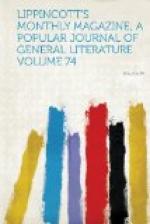This information was dear to the historic instinct of Marcoy. He spoke, by his usual proxy, to the Indian of the oriole, commanding him not to begin every explanation by laughing, as he had been doing, but to answer intelligently, promising a reward of several knives. The savage exchanged a rapid glance with his fellows, and then he and they stood up as stiff and mute as the trees. Marcoy then asked him if he had never heard his father or his grandfather speak of the great city of San Gavan, built hereabouts formerly by the Spanish chevaliers, and which the Caranga and Suchimani Indians from the Inambari River had destroyed by fire.
The evident recognition of this legend by the savages, and their rapid exchange among themselves of the words sacapa huayris Ipanos, induced Marcoy to ask if they could guide them to the site of the former city. They answered that a day’s march would be sufficient, and pointed with their arms in the direction of north-north-west.
The temptation to see the place whose golden renown, after having made the tour of the American continent, had reached Spain and the world at large, was too strong to be resisted. Colonel Perez, besides the magic attraction which the mention of gold had for him, felt his national pride touched by the idea of a place where his compatriots had added such magnificence to the Spanish name, and gained so many ingots of gold by paddling in the streams. The cascarilleros were delighted to extend their journey, in hopes of yet larger discoveries. As for the porters, since the manifestations of the savages they clung to the party with as much anxiety as they had ever shown to escape from it.
In 1767 the city of San Gavan, remaining intact amid the ruin of all its neighbors, was the sole disburser of the riches of the Caravaya Valley. The gold-dust, collected throughout the whole territory on a government monopoly, was brought thither upon the backs of Indians, melted into ingots, and distributed to Lima and the world at large. On the night of the 15th and 16th of December in that year the wealthy city was fired by the Carangas and the Suchimanis, and all the inhabitants slain with arrows or clubs. The first lords of the soil had resumed their rights.
When the news of the event was brought to Lima, the viceroy of the period, Antonio Amat, swore on a piece of the true cross to exterminate every Indian in Peru. It is to the persuasions of his favorite, Mariquita Gallegas, that the preservation of the native tribes from a bloody extirpation is due. This woman, La Perichola, whose caricatured likeness we see in the most agreeable of Offenbach’s operas, and whose deeds of mercy and edifying end in a convent entitle her to some charitable consideration, persuaded her royal lover to operate on the natives with missionaries and teachers rather than with fire and sword. Antonio Amat yielded, and the Indians have survived.
[Illustration: “ANOTHER SAVAGE HAD FOUND A PAIR OF LINEN PANTALOONS.”—P. 146.]




